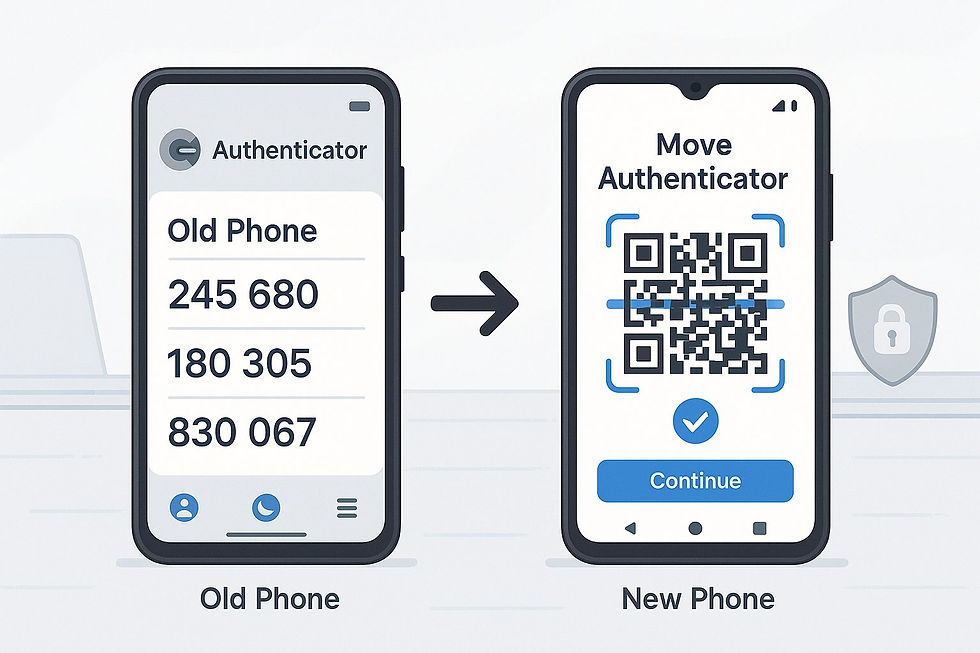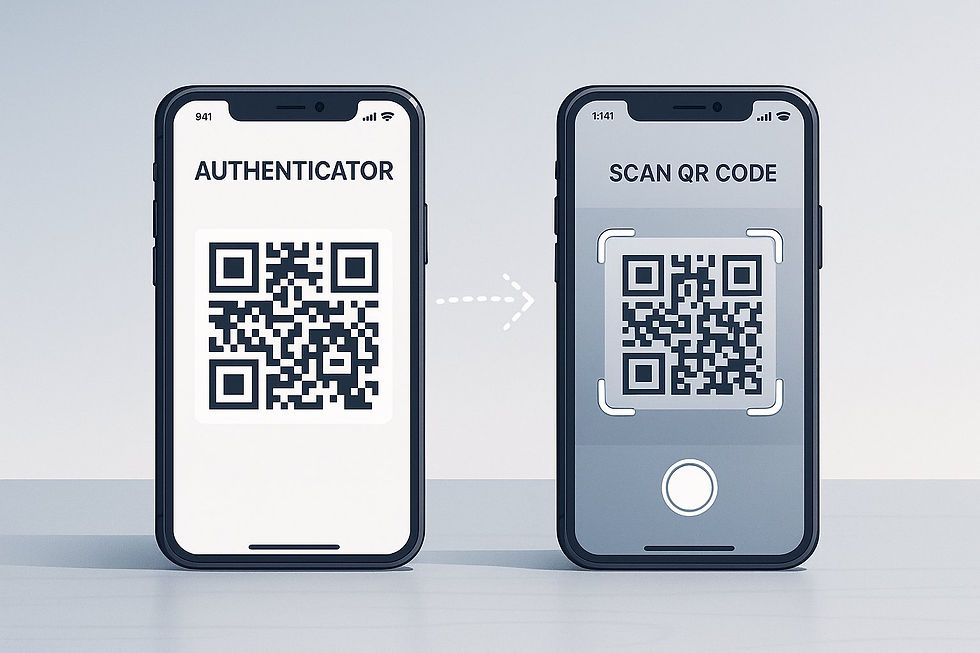Moving Authenticator App to New Phone: Step-by-Step Guide
- The Master Sensei

- Sep 4
- 4 min read
Getting a new phone is always a bit of a thrill, but let's be honest—it usually comes with a twinge of panic about losing access to accounts protected by two-factor authentication. Nobody wants to get locked out of their email, bank, or work apps just because they upgraded their device.

Luckily, you can move your authenticator app to your new phone thanks to cloud backup features that keep your authentication codes and account access safe. Microsoft Authenticator, Google Authenticator, and other big-name apps include built-in transfer tools that save you from the headache of setting up every account from scratch.
You’ll need to back up your authenticator data and then restore it on your new phone. Sometimes, certain accounts might make you jump through a few extra hoops for verification. Prepping ahead of time helps you avoid losing access to anything important.
Preparing to Move Authenticator App
Before you switch phones, make sure you’ve set up cloud backup and double-checked your account settings. If you’re on iOS, iCloud backup needs to be enabled, and everyone should confirm their Microsoft account recovery info.
Backing Up Authenticator Data With Cloud Backup
Cloud backup is hands-down the easiest way to transfer your authenticator accounts. Turn this on before you swap phones, or you risk losing access.
Open Microsoft Authenticator, tap the three dots in the corner, and hit Settings.
Scroll to the Backup section and flip the Cloud Backup switch on.
The app will ask you to sign in with your Microsoft account. That account becomes your recovery lifeline for restoring data on the new phone.
Heads up, there are a few limits:
Work and school accounts might need you to re-verify
Some third-party accounts have to be set up manually
Backup space isn’t unlimited
Double-check your backup by making sure your accounts show up in the cloud storage. It’s worth confirming the backup actually finished before you go any further.
Enabling iCloud Backup on iOS Devices
If you’re on iPhone, you’ll need to enable iCloud backup just for the authenticator app. It’s a bit different from the usual cloud backup.
Go to Settings, tap your name at the top, then choose iCloud.
Scroll until you see Microsoft Authenticator in the list and toggle it on for iCloud backup.
Make sure you’ve got enough iCloud storage. You can check by tapping Manage Storage in the iCloud settings.
iCloud backup needs a few things:
You need the same Apple ID on both devices
iOS 14 or higher is best
You’ll want a solid internet connection during backup
Check the last backup date in iCloud settings to be sure it worked. The timestamp should match your recent backup.
Verifying Microsoft Account and Recovery Settings
Before you move anything, log into your Microsoft account online and check your recovery settings. Outdated info can mess up the whole process.
Sign in through a browser, go to Security settings, and review your recovery details.
Make sure to check:
Your main email is up to date
Your SMS recovery phone number works
Alternate emails are active
Security questions are still correct
If anything’s outdated, update it now. Test your recovery options by requesting a verification code to make sure everything works.
The Microsoft account you use for backup has to be the same one you use for restoring. If you use a different account, your data won’t sync across devices.
Write down the exact Microsoft account email you used for backup. Keep it somewhere safe—definitely not just on your phone.
Transferring Microsoft Authenticator to a New Phone
Once you’ve backed up your data, it’s time to restore your accounts on your new phone. Some accounts might ask for extra validation, and when you’re done, remove the app from your old device.
Restoring Backup on the New Device
Download Microsoft Authenticator from the app store on your new phone—it’s on both Android and iPhone.
Open the app and tap Begin recovery when you see the setup screen. Sign in with the same Microsoft account you used for backup.
The app will start restoring your accounts automatically. If you have a lot of accounts, give it a few minutes.
If you use a business account, make sure you sign in with your work Microsoft account (not your personal one). Business and personal backups don’t mix.
As the restore finishes, your account list should fill in. Your two-factor codes should start showing up right away.
Revalidating Accounts After Transfer
Some accounts just aren’t satisfied—they’ll want you to verify again after you transfer. The app will flag any that need your attention.
Usually, you’ll need to sign in to those accounts via a browser or their own app. They’ll prompt you to approve the sign-in using your new authenticator setup.
You might have to:
Scan a new QR code from the account’s settings
Enter a code from the app
Confirm your identity by email or SMS
Business accounts can be pickier. Sometimes IT has to approve your new device before you get back in.
Try signing in to each account and use the codes to make sure everything’s working. Better safe than sorry, right?
Troubleshooting Common Transfer Issues
If restoration fails, check that you’re signed in with the same Microsoft account you used for backup. Using a different one? That’s usually the culprit.
If some accounts are missing after restoration, chances are the backup wasn’t complete. You can always add those accounts manually—just scan their QR codes from your account settings.

Removing Authenticator App from Old Phone
Make sure all your accounts work on the new phone before you remove the Microsoft Authenticator app from the old one. Otherwise, you might lock yourself out of something important—nobody wants that headache.
To get rid of the app, just uninstall it using your phone’s usual method. Tap and hold, drag to uninstall, or whatever your device prefers.
It’s a good idea to sign out of any Microsoft accounts inside the app’s settings first. This can help you dodge annoying issues when you set things up on your new phone.
If you’re planning to sell, recycle, or toss your old device, wipe everything with a full factory reset. Just deleting the app isn’t enough—your authentication data could still linger otherwise.
If you use a business account, check in with your IT department before switching devices. Some companies keep tabs on where authenticator apps are installed for security reasons.
















































Comments